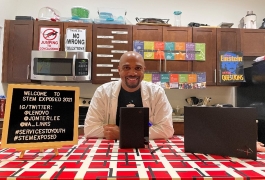How to Kill Public Speaking Jitters
Last updated 12/7/2020

As a science student, you will at some point in your college career need to explain experimental results or give a talk about your research either in class or at an event. In your professional career, it is inevitable that you will share information with a team or an audience. Giving presentations, no matter how small or large the audience is, can be nerve-racking. For some people, it’s downright dreadful.
If the thought of getting up in front of others gives you the heebie-jeebies, you’re not alone. By some estimates, more than 70% of people get anxious about public speaking, ranging from the jitters to full-on glossophobia (fear of public speaking). Public speaking is a necessary skill for chemical professionals in any field. Whether sharing the results of an experiment with your team, demonstrating the value of your projects to your boss, or presenting your research at a professional meeting, you can expect to spend a good chunk of your professional life talking in front of other people.
So we turned to undergraduate students who attended the 2019 ACS Leadership Institute. All of them have been where you are. Here, they share how they overcame their fears and got comfortable with giving presentations.
Design a presentation you feel good about
Start by believing in your presentation and designing it to be as easily digestible as possible. Whether you’re giving a poster (see poster tips) or oral presentation, the best PowerPoints and posters are highly visual and rely more on graphs and images than words. In fact, it’s better to have “less words on the screen and use more words in speaking” advises Bao Nguyen, Vice President of the Plymouth State University ACS Student Chapter. An audience that is busy reading a lot of text or trying to decipher complex charts isn’t paying attention to you.
Nguyen thinks of presentations as telling a story and Thomas Tyson, a student at Florida Southern College student and the 2019 student liaison to the ACS Undergraduate Programs Advisory Board, agrees. “More difficult to understand does not equate to smarter,” Tyson says. “Create your presentation so that it flows logically and use analogies when appropriate,” he adds.
Lauryn Gist-Reed from Xavier University of Louisiana recommends making sure you know everything that’s visually represented on your presentation. “If you’re confident that you know everything, it’s not intimidating to present,” she says. Irkramul Hasan from the University of Dhaka in Bangladesh agrees. “If you can feel the topic from your heart you can take your speech to the heart of the audience.”
Cameron Johns, Vice President of the University of Detroit Mercy ACS Student Chapter, prepares presentations by trying to predict questions that may be asked. Predicting audience reactions often gives you deeper insights into your own work and can help you get ready for common questions.
Know your audience... and yourself
Madelyn Kist, a member of the Kent State University ACS Student Chapter, advises tailoring your presentation to the level of the audience.
“Is it a room full of elementary school-aged children at an outreach event, or is it a panel of distinguished professors critiquing your work? Aim to use analogies and phrasing that your specific audience will relate to, while still communicating your overall idea to them successfully. It takes some practice but is very rewarding," says Kist.
Although your professors may be intimately familiar with your work, other researchers and future employers are not, so you will need to use simpler terminology with the latter audience. Whether speaking before a young audience or more mature crowd, nervousness can happen to anyone, and you shouldn’t beat yourself up over feeling overwhelmed with self-doubt. “I’m very new to research and have only been presenting for a few months,” says Kist. “I wish someone would have told me that public speaking is not natural to everyone and, like any other skill, you must put time into it and develop it.”
When the pressure is on, you could lose your train of thought, feel stiff, or get anxious. To combat these very normal jitters, Katie Coscia from Georgia Gwinnett College and Carly Masonheimer from Bucknell University recommend writing out either a list of key points or even a complete script of what you want to say. Having a planned talk and rehearsing it is your best weapon for dealing with the heat of the public speaking moment.
When you’re anxious, it can feel like people are just waiting for you to mess up. They aren’t. As Coscia points out, “Nobody in that room wants you to fail; everyone is there to see you take control of that room, be proud of your hard work, and share your science with them.”
Do you dread giving talks? Turn fear into joy with these four keys
Get in front of people to get ready
“Practice. Practice. Practice.”
So says Tyson… and almost everyone else we asked. Whether it’s a poster, oral presentation, or outreach demo, walking through what you are going to say as many times as humanly possible will help increase your confidence, make you completely familiar with your topic and how you want to deliver it, and fine-tune your explanations so you aren’t struggling for the right words on the spot. “Familiarity is the key to overcoming fear," says Quingrong Zou, a student chapter leader at Chongqing University in China. “The more fully rehearsed in advance, the more comfortable you will be onstage.”
Sara Elnztawy, President of the Alexandria University ACS Student Chapter, suggests practicing in front of different audiences, “starting with family and friends and progressing up to a mentor or advisor.” Practicing in front of people will kill those initial nerves and give you a higher level of comfort talking in front of an audience than you would otherwise have. It’s also a great way to get feedback and help you craft a better presentation.
In a similar vein, be sure to practice speaking slowly. When you’re nervous, your speech quickens, making your presentation that much harder for the audience to process. Slow down, and make eye contact with different audience members throughout your talk.
Rock your presentation
On the day you’re going to deliver your presentation, find the location of your session before you present. Identify the most efficient route to the location from wherever you will be beforehand, plus a backup route. This is especially useful at ACS national meetings where sessions are spread out over large spaces. If possible, scope out the room so that you feel comfortable in the space. If you are using audiovisual resources, make sure everything works ahead of time.
In most professional presentations, you only get a few minutes to set up. This is no problem for posters, which only take 3-4 minutes to hang (especially if you remember to bring your own pushpins). With oral presentations, you run the risk of technical difficulties, so allow yourself 15-20 minutes to resolve them. With outreach demos, you may want 30-60 minutes to address any safety issues that pop up at the last minute.
If you are presenting as part of a symposium, there will be a session moderator to manage the timing and assist with technical difficulties. Arrive 15 minutes before the symposium starts and be prepared to either load your presentation onto the session’s computer or make sure your computer is compatible with their system.
When it’s time to speak, trust yourself! You’ve done all you could do to prepare—you’ve designed a great presentation, you’ve practiced your heart out, you’ve taken notes from feedback, and you practiced some more.
Jonah Ralston from Tennessee Technological University says that when you are speaking, “remember to breathe and try to keep yourself calm.” A slow, deep breath (from your belly, not your chest) forces your body to relax a little and gives you time to collect your thoughts. It may feel like unbearable silence, but your audience won’t even register it.
Whatever you do, do not open with an apology. Uninvited apologies immediately focus the audience’s attention on what’s wrong. You do not need to apologize for being nervous—everybody is, and everyone understands that this is a new experience for students.
While you are giving your presentation, it’s possible that you may get tripped up in spite of all the preparation. Again, this is perfectly normal and happens all the time to newbies and seasoned speakers alike.
Here's what to do if you:
Make a mistake: If it is glaringly obvious or interferes with your presentation (such as having the wrong molecular structure on the slide), acknowledge the mistake, provide the correct information, and move on. If it’s a minor mistake that no one appears to notice (such as an incorrect date), don’t worry about it; calling attention to it will distract from your message, so ignore it for now.
Lose your place: Take a slow, deep breath, then check your notes to get yourself back on track. Pausing to get on track may feel like a lot of dead air, but in reality, it’s just a few seconds that gives you time to regroup and your audience a chance to process what you’re saying.
Get a tough question: No one has all of the answers. If you get stumped, just say, “That’s a great question! Can we discuss it further after the presentation?” You can also say, “I don’t know, but I’ll find out.” Either way, following up with the questioner afterward is a great opportunity to get fresh insight and possibly a new contact for your professional network.
Have a heckler: Stay calm. As soon as you can get a word in edgewise, say: “Thank you for your comments. Let’s explore this further afterwards, so that we can stay on schedule/let someone else ask a question.” Then move on. No one likes hecklers, so you have nothing to lose by sticking to the high ground.
Have a more severe phobia: If you find yourself getting sick, having panic attacks, or anything more than a little anxiety over public speaking, try allowing yourself extra practice. Remember, the more you practice, the more you will be able to alleviate some of those fear-inducing symptoms. You may also want to consider joining your local Toastmasters group. It’s a safe environment to practice speaking.
After you’ve presented a few times (it could be two or 10), each experience should be less and less intimidating. And each time you conquer your fear and do it, you’ll probably take something away that you can apply to next time. If you find that you’re not improving or continue to feel overcome by fear and anxiety, speaking with a mental health professional to calm your fears may be a good option for you; they are equipped to help you chip away at your phobia.
With a little support and a lot of practice, anyone can become a great public speaker.




